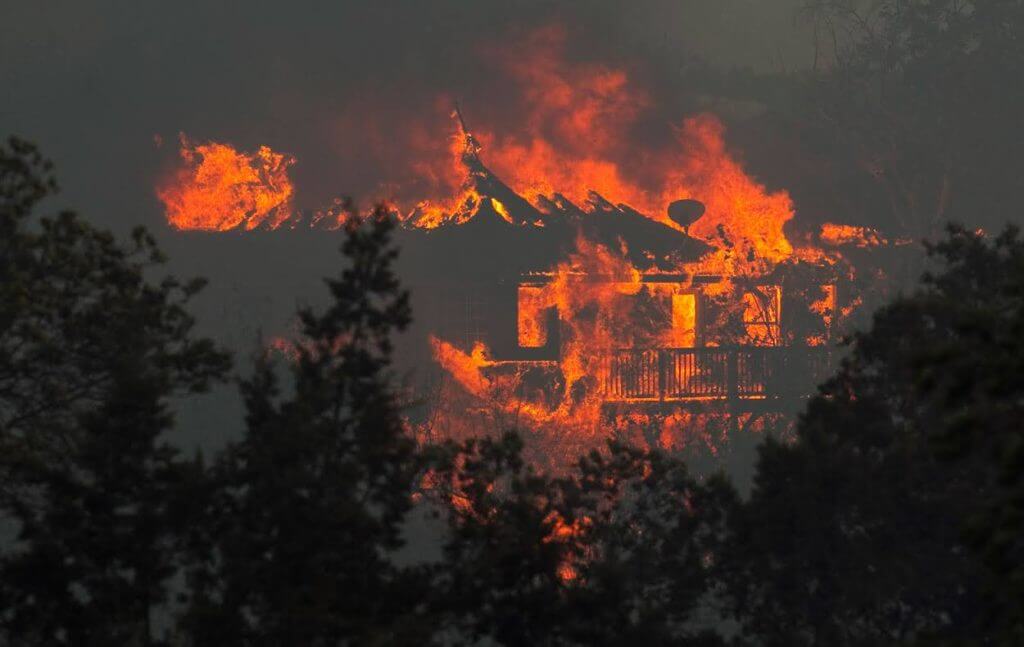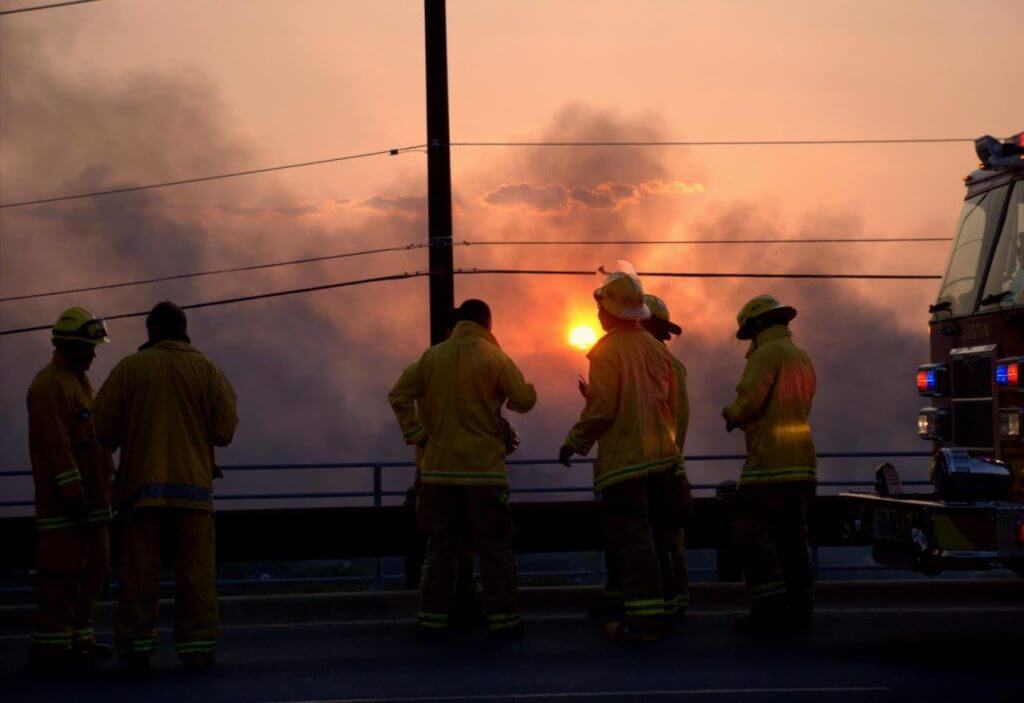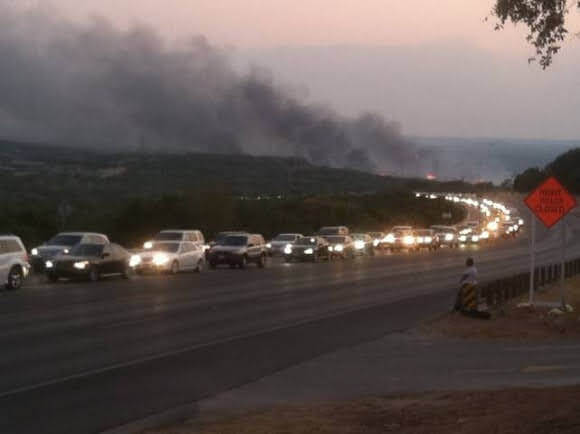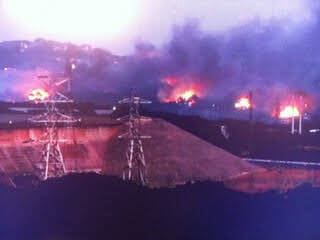

By LYNETTE HAALAND, Four Points News
On Sept. 4, 2011, wildfire was reported moving toward Steiner Ranch at 3:58 p.m.
A few minutes earlier on that Sunday afternoon, electrical lines along RM 620 near Mansfield Drive “had enough slack to slap and arc, causing molten metal to fall onto combustible grass,” according to the then Travis County Fire Marshal Hershel Lee.
The fire, which started on an undeveloped residential lot, was carried by embers across RM 620, igniting dry vegetation and moving into the Steiner Ranch subdivision. Within hours, the fires destroyed 23 homes.
At its peak, 300 firefighters were attacking the fires as they swept through 162 acres of Steiner.
There were over 300 homes saved during the fires but in addition to the 23 lost, three homes suffered structural damage. Twenty eight properties had exterior, non-structural damage such as landscape and privacy fences.
Steiner suffered an estimated $10 million in fire losses.
The Travis County Fire Marshal’s Office fire investigative team studied the area for months, analyzing burn patterns, taking witness statements, watching video footage and conducting site visits.
The official cause of the initial fire was released 14 months later: electrical lines came into contact with one another, arced, ignited grass and spread by high winds.
“The exceptional drought, low humidity and high winds and temperature combined to create conditions that were ripe for fire ignition,” explained Lee in November of 2012.
Robert Abbott remembers that Labor Day weekend. He was assistant fire chief then of the Lake Travis Fire Rescue Travis County Emergency Services District No. 6.
“The Texas fire service learned a great deal on September 4, 2011 as the entire state faced catastrophic and fatal fires,” said Abbott, who is now LTFR fire chief. “Locally, the Steiner Ranch fire tested our systems – some worked, some failed. It was a turning point in how firefighters are trained, equipped, and resourced.”
Steiner’s fire was one of six that were burning in Travis County on Sept. 4, 2011. Resources from all fire departments were stretched to their limits.
A decade ago, the entire Steiner Ranch community was evacuated which caused hours and hours of major back ups and bumper to bumper traffic leaving the area on RM 620 north, opposite of where the fire started.
Officials realized the evacuation was poor and since then have worked on several initiatives that will help things run better in a disaster.
Improvements
One major thing, Travis County approved adding a new, emergency-only road in July 2019. Route B will connect Flat Top Ranch Road to Montview Drive between the Steiner and adjacent Montview communities. The $650,000 roadway is still in the design phase and is to start construction later this year, about a year behind schedule.
“We support it (the emergency road) in any way. We support any additional way in and out,” Abbott said.
Another thing that the county has been involved in is identifying shelter-in-place sites and never expects to evacuate an entire community again. It is one of the things the Fire Marshal’s Office has been doing, said Travis County Commissioner Brigid Shea, Precinct 2.
“People won’t all need to evacuate,” said Shea in a previous FPN interview. “We’re paying more attention to these shelter-in-place locations.” Examples include Longhorn Village, school campuses, and large parking lots at local shopping centers because there’s not much flammable material around the buildings.
Since the 2011 fires, the county now has better mapping tools to find exact locations.
Another tool officials will use in future emergency situations is contra-flow evacuation by making all lanes of traffic go the same direction. Officials have set up better traffic controls and traffic management systems.
A decade later a much more effective emergency communications system is in place across the region with Warn Central Texas. Shea advocated for this better emergency notification system.
Shea was also instrumental in working with the Comanche Trail community on hosting a fire drill on March 2, 2019. It took more than a year to plan for the three-hour evacuation. This helped the community prepare for and train for a real emergency, she said.
Additionally, communities have forged legitimate risk reduction programs such as fuel mitigation projects, emergency preparedness, and Firewise planning, Abbott said.
“It was not surprising the community came together as it did and as a result has become more resilient over time,” Abbott said. “It is important that the experience doesn’t become an afterthought, but on the minds of everyone tasked with building communities, funding public safety to be equipped and prepared, and community preparation focused on reducing the threat of wildfire in and around their own homes.”

LTFR improves firefighting, preparedness
Since 2011, Lake Travis Fire Rescue Emergency Services District No. 6 has implemented several key initiatives to help fight fires more strategically, to use the latest techniques, and to educate the community more about fire.
Today LTFR is better able to handle a wildfire emergency like the Steiner Ranch fires a decade ago.
LTFR fire chief Robert Abbott said, “LTFR has learned a great deal from the 2011 wildfires and since has implemented the following:”
- Enhanced the training and resource response through the Austin/Travis County Fire Automatic Aid Agreement which assigns the closest fire unit to emergencies greatly reducing response times (2011)
- Increased participation in the Texas Intrastate Mutual Aid System. This program increases the available fire resources throughout the state of Texas. (2011)
- A full-time fuel mitigation program focused on reducing the available fuel load (vegetation) in a prescribed and environmentally sensitive manner following the U.S. Fish and Wildlife protocols. (2012)
- Increased staffing levels to a minimum of four personnel per station 24/7. (2014)
- A full-time wildfire specialist position focused on community education and home risk reduction programs. LTFR offers free home risk assessments and can be scheduled by Chris Rea at crea@ltfr.org. (2016)
- The Community Emergency Preparedness Series which include three 2-hour sessions of training tailored to a community’s specific needs relating to emergency training (“Stop the Bleed” bleeding control, fire extinguisher operation, CPR, etc.), evacuate and shelter-in-place planning, and home risk reduction programming (2019)

SEPT 12, 2011
Steiner suffers an estimated $10 million in fire losses
By LYNETTE HAALAND, Four Points News
Lake Travis Fire Rescue reports the Steiner Ranch fires totaled an estimated $10 million in losses as 23 homes burned to the ground and fire swept through 162 acres of the community.
Firefighters continue to be on high alert as conditions for wildfires are ripe just one week after thousands of evacuated residents were allowed to return home.
On Friday, LTFR declared the Steiner fires were contained and controlled as of 5 p.m., five days after the first sparks began.
“We are still out there today (Monday) along with the U.S. Fish & Wildlife Service engine. We are more and more comfortable everyday,” said Jim Linardos, LTFR Fire Chief.
The fire department will wrap up in a day or two. “We’re cautious and doing everything it takes to make sure the fires are out,” he said.
There were over 300 homes saved during the fires but in addition to the 23 lost, three homes suffered structural damage. Twenty eight properties have exterior, non-structural damage such as landscape and privacy fences.
The fires also caused six minor firefighter injuries and the loss of one family dog. There were no civilian injuries or fatalities although Travis County Corporal Kevin Aigner suffered breathing difficulties while on duty guarding the burned properties and then later died at Seton Medical Center.
Looking back, Linardos said these were hard fires to fight. At its peak, 300 firefighters were attacking the blazes.
The green belts have big drop offs making it harder to get to all of the places the fires had spread. “We had to use a lot of foot traffic to contain these fires,” Linardos said.
The Steiner fires were wind driven fires and classified as “dirty burning fires” meaning they left areas of unburned fuel, he said. That makes the mop up that much longer because the brush and trees burn longer, taking more time to extinguish. Also there were underground fires where organic material such as leaves or old grass or root systems were burning.

